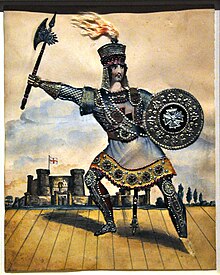
Ernst Ingmar Bergman was a Swedish filmmaker and theatre director. Widely considered one of the greatest and most influential screenwriters and film directors of all time, his films have been described as "profoundly personal meditations into the myriad struggles facing the psyche and the soul". Some of his most acclaimed works include The Seventh Seal (1957), Wild Strawberries (1957), Persona (1966), and Fanny and Alexander (1982); these four films were included in the 2012 edition of Sight & Sound's Greatest Films of All Time. Bergman was also ranked No. 8 on the magazine's 2002 "Greatest Directors of All Time" list.

Liv Johanne Ullmann is a Norwegian actress and film director. Recognised as one of the greatest European actresses of all time, Ullmann is known as the muse and frequent partner of filmmaker Ingmar Bergman. She acted in many of his films, including Persona (1966), Cries and Whispers (1972), Scenes from a Marriage (1973), The Passion of Anna (1969), and Autumn Sonata (1978).

Laurence Kerr Olivier, Baron Olivier, was an English actor and director who, along with his contemporaries Ralph Richardson and John Gielgud, was one of a trio of male actors who dominated the British stage of the mid-20th century. He also worked in films throughout his career, playing more than fifty cinema roles. Late in his career he had considerable success in television roles.

Max von Sydow was a Swedish-French actor. He had a 70-year career in European and American cinema, television, and theatre, appearing in more than 150 films and several television series in multiple languages. Capable in roles ranging from stolid, contemplative protagonists to sardonic artists and menacing, often gleeful villains, he received numerous accolades including honors from the Cannes Film Festival and the Venice Film Festival. He was nominated for two Academy Awards: for Best Actor for Pelle the Conqueror (1987) and for Best Supporting Actor for Extremely Loud and Incredibly Close (2011).

A theatre director or stage director is a professional in the theatre field who oversees and orchestrates the mounting of a theatre production such as a play, opera, dance, drama, musical theatre performance, etc. by unifying various endeavors and aspects of production. The director's function is to ensure the quality and completeness of theatre production and to lead the members of the creative team into realizing their artistic vision for it. The director thereby collaborates with a team of creative individuals and other staff to coordinate research and work on all the aspects of the production which includes the Technical and the Performance aspects. The technical aspects include: stagecraft, costume design, theatrical properties (props), lighting design, set design, and sound design for the production. The performance aspects include: acting, dance, orchestra, chants, and stage combat.

Hedda Gabler is a play written by Norwegian playwright Henrik Ibsen. The world premiere was staged on 31 January 1891 at the Residenztheater in Munich. Ibsen himself was in attendance, although he remained back-stage. The play has been canonized as a masterpiece within the genres of literary realism, nineteenth century theatre, and world drama. Ibsen mainly wrote realistic plays until his forays into modern drama. Hedda Gabler dramatizes the experiences of the title character, Hedda, the daughter of a general, who is trapped in a marriage and a house that she does not want. Overall, the title character for Hedda Gabler is considered one of the great dramatic roles in theater. The year following its publication, the play received negative feedback and reviews. Hedda Gabler has been described as a female variation of Hamlet.
Sir Trevor Robert Nunn is a British theatre director. He has been the artistic director for the Royal Shakespeare Company, the Royal National Theatre, and, currently, the Theatre Royal Haymarket. He has directed dramas for the stage, like Macbeth, as well as opera and musicals, such as Cats (1981) and Les Misérables (1985).
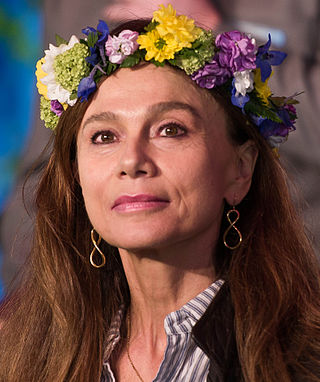
Lena Maria Jonna Olin is a Swedish actress. She has received nominations for an Academy Award, a Golden Globe Award, a BAFTA Award, and a Primetime Emmy Award.

Fanny and Alexander is a 1982 period drama film written and directed by Ingmar Bergman. The plot focuses on two siblings and their large family in Uppsala, Sweden during the first decade of the twentieth century. Following the death of the children's father, their mother remarries a prominent bishop who becomes abusive towards Alexander for his vivid imagination.
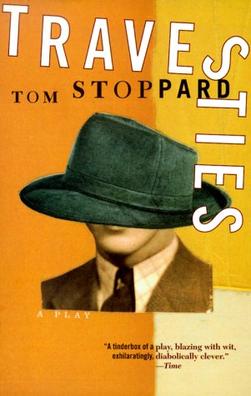
Travesties is a 1974 play by Tom Stoppard. It centres on the figure of Henry Carr, an elderly man who reminisces about Zürich in 1917 during the First World War, and his interactions with James Joyce when he was writing Ulysses, Tristan Tzara during the rise of Dada, and Lenin leading up to the Russian Revolution, all of whom were living in Zürich at that time.
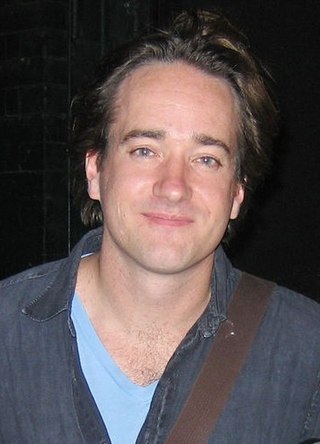
David Matthew Macfadyen is an English actor. Known for his performances on stage and screen, he gained prominence for his role as Mr. Darcy in Joe Wright's Pride & Prejudice (2005) and for his role as Tom Wambsgans in the HBO drama series Succession (2018–2023). He has received several awards including a Primetime Emmy Award and two BAFTA Television Awards.
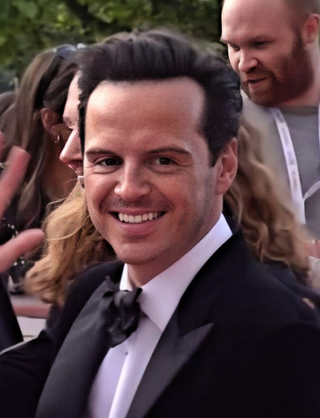
Andrew Scott is an Irish actor. Known for his roles on stage and screen, he has received numerous accolades, including a BAFTA TV Award and two Laurence Olivier Awards, as well as nominations for a Primetime Emmy Award and a Golden Globe.
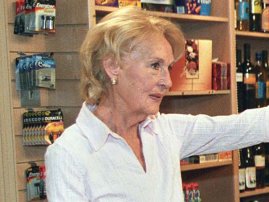
Joan O'Hara was an Irish stage, film and television actress. She was one of Ireland's most popular actresses and was, at her death, recognisable to television viewers as Eunice Dunstan, a gossip in Fair City on RTÉ One.

The Magic Flute is Ingmar Bergman's 1975 film version of Mozart's opera Die Zauberflöte. It was intended as a television production and was first shown on Swedish television on 1 January 1975, but was followed by a theatrical release later that year. The work is widely viewed as one of the most successful films of an opera ever made, and as an unusual item among the director's works. The film won BAFTA TV Award for Best Foreign Television Programme in 1976 and was nominated for Golden Globe for Best Foreign Language Film.

George Victor Speaight FRSA was a theatre historian, author and performer and the leading authority on 19th-century toy theatre.

Noma Dumezweni is a South African-British actress. In 2006, she won the Laurence Olivier Award for Best Performance in a Supporting Role for her performance as Ruth Younger in A Raisin in the Sun at the Lyric Hammersmith Theatre. In 2017, she won the Laurence Olivier Award for Best Actress in a Supporting Role for her performance as Hermione Granger in the original West End run of Harry Potter and the Cursed Child; she reprised the role for the show's original Broadway run and, in 2018, was nominated for the Tony Award for Best Featured Actress in a Play.

An actor or actress is a person who portrays a character in a production. The actor performs "in the flesh" in the traditional medium of the theatre or in modern media such as film, radio, and television. The analogous Greek term is ὑποκριτής (hupokritḗs), literally "one who answers". The actor's interpretation of a role—the art of acting—pertains to the role played, whether based on a real person or fictional character. This can also be considered an "actor's role," which was called this due to scrolls being used in the theaters. Interpretation occurs even when the actor is "playing themselves", as in some forms of experimental performance art.
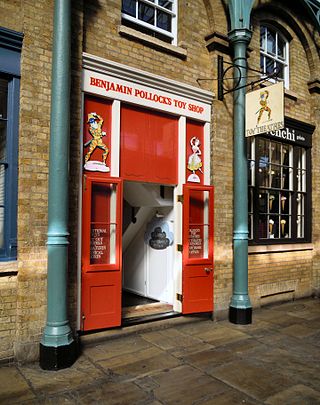
Benjamin Pollock's Toy Shop is a shop selling vintage and retro toys in London's Covent Garden. One of the oldest toy shops in London, it had its origins in Hoxton in 1851 before being taken over in 1877 by Benjamin Pollock, who ran it until his death in 1937. Coronation Street actor Peter Baldwin co-owned the shop from 1988 to his death in 2015. Located at 44 The Market Building, Benjamin Pollock's Toy Shop specialises in Victorian toy theatres, both original and reproduction, in addition to books, puppets, music boxes and other traditional toys.
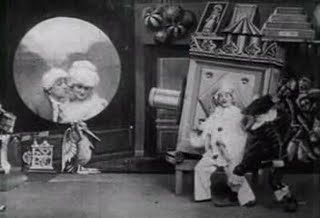
La Lanterne magique, sold in the United States as The Magic Lantern and in Britain as The Magic Lantern, or the Bioscope in the Toy Shop, is a 1903 French short silent film by Georges Méliès. It was sold by Méliès's Star Film Company and is numbered 520–524 in its catalogues.
Rae Smith is a British set and costume designer who has worked frequently in theatre and Live Art. Her designs can be seen in the Opera Rigoletto which received a South Bank Sky Arts Award as did ‘’[Uncle Vanya ] film and West End Production in 2022. Saint Joan, an Obie Award for Oliver Twist and an Irish Times award for An Ideal Husband. Smith was nominated for Laurence Olivier Awards for The Light Princess, Uncle Vanya and Rosmersholm. Her work on the set of War Horse received particular praise and she received an Olivier, Tony, Evening Standard, Toronto Critics and Drama Desk Special Award. Smith has also worked on several operas and ballets.

